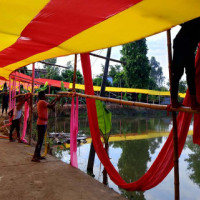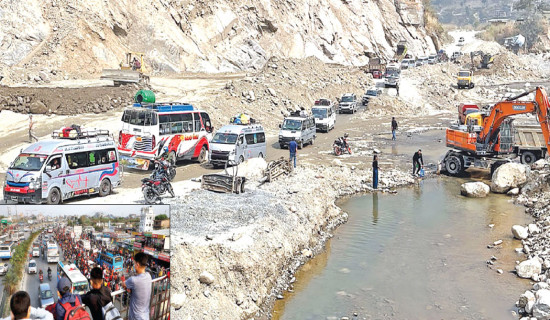- Friday, 24 October 2025
Govt enhances disaster readiness amid rising monsoon challenges
Kathmandu, June 8: Nepal ranks among the most vulnerable countries globally in terms of climate change impacts and recurring natural disasters, according to recent data from the National Disaster Risk Reduction and Management Authority (NDRRMA).
The nation faces significant risks from monsoon-induced calamities such as floods, landslides, and lightning strikes, which continue to result in substantial human and economic losses each year.
Globally, Nepal ranks 11th in earthquake vulnerability, 30th for hydro-meteorological disasters, and 4th in climate-related hazards including droughts, floods, and landslides. Despite its minimal contribution to global greenhouse gas emissions—ranking 190th—Nepal bears a disproportionate burden of climate-related adversities.
Each monsoon season, torrential rainfall combined with the country’s mountainous terrain and river systems flowing southwards from the Himalayas trigger devastating floods and landslides.
2,317 dead, 419 missing in one decade
The NDRRMA reports that these disasters annually cause significant casualties and damage to infrastructure, homes, and livelihoods. In the past decade alone, over 8,418 disaster incidents have been recorded, leaving more than 2,300 people dead, 419 missing, and 2,649 injured due to weather-related hazards such as floods, landslides, lightning, and heavy rainfall. Approximately 56,705 families have been affected during this period.
Unplanned infrastructure development—particularly roads constructed without proper environmental impact assessments—has further intensified the risk of landslides and flash floods. The country faces an estimated 3–5% annual GDP loss due to disaster-related damages.
Last year alone, Nepal witnessed 2,138 disaster events resulting in 495 deaths, 522 injuries, and 66 missing persons. The Department of Hydrology and Meteorology has projected above-average rainfall this monsoon season, with some regions expected to receive 35–45% more precipitation than usual.
Last year throughout monsoon season, 1,670.7 mm rainfall had been measured in the last 125 days of monsoon (June 11 to October 12), which is 22 per cent more than the normal rainfall (1,379.1 mm).
This year, areas identified for increased rainfall include the northwestern parts of Sudurpaschim, southeastern Bagmati, central Madhes, and central to mid-western Koshi Province.
Nearly 2 million people may be affected
The NDRRMA estimates that nearly 1.99 million people of 457,145 households could be affected by monsoon-related disasters this year, with about 200,000 families likely to experience direct impacts. Last year, 10,823 families had been affected in which 8,586 houses were fully damaged. Also last year 244 concrete bridges/suspension bridges, 189 schools, 150 government offices, and 85 hydropower infrastructures had been damaged.
Last year, during the monsoon period, 71 local levels across 20 districts were declared disaster-crisis areas for the duration of three months.
This year, according to the province-wise projected figures possible directly affected population and households include: 275,867 population of 63,127 families or households in Koshi Province, 228,687 population of 52,331 families in Madhes Province, 327,376 population of 74,914 families in Bagmati Province, 287,107 population of 65,699 families in Gandaki Province, 523,656 population of 119,830 families in Lumbini Province, 127,308 population of 29,132 families of Karnali Province, and 227,730 population of 52,112 families in Sudurpaschim Province.
Landslides in hilly areas and floods in the southern plains (Tarai) are expected to be the most damaging, with authorities warning of potential loss of life and property.
Rain forecast for the year 2025
According to the Meteorological Forecasting Division under the Department of Hydrology and Meteorology, during the monsoon season of this year, there is a 55% to 65% probability of above-average rainfall in the eastern part of Karnali Province, the northern region of Lumbini Province, and most parts of Gandaki Province.
In the southern region of Sudurpashchim Province, the western part of Lumbini Province, the northern region of Gandaki Province, and the northern areas of Bagmati and Koshi Province, there is a 45% to 55% probability of receiving above-average rainfall.
Meanwhile, in the eastern and southern regions of Madhes Province, there is a 35% to 45% chance of above-average rainfall.
The department has also indicated that other regions of the country are likely to have 35% to 45% probability of higher-than-average rainfall during this monsoon period.
Last year, monsoon in Nepal entered on June 11, 2024 and this year, it had already arrived on May 29.
Last year, the most-monsoon affected districts included Taplejung, Panchthar, Sankhuwasabha, Sindhupalchok, Rasuwa, Chitwan, Lamjung, Parbat, Myagdi, eastern Nawalparasi, Gulmi, Dang, Bajura, and Kaski.
Disaster response mechanism
The government has initiated proactive disaster preparedness and response measures, focusing on early warning systems (45 sirens in 39 districts), evacuation plans, and inter-agency coordination. Authorities stress the importance of community-level awareness and resilience building as critical tools in mitigating monsoon-related risks.
In anticipation of potential monsoon-induced disasters, the Ministry of Home Affairs, relevant authorities, and key stakeholders have activated a coordinated national response strategy, including the deployment of ‘composite quick reason team (CQRT)’ in high-risk areas and efforts to address resource gaps for search, rescue, and relief operations within 15 minutes of the information. CQRT team has been managed with aerial service remaining standby in Kathmandu.
According to Ram Bahadur KC, Undersecretary and, Spokesperson for the National Disaster Risk Reduction and Management Authority (NDRRMA), siren-based early warning systems have been installed at 49 early warning system (sirens) in 13 districts including Saptari, Rautahat, Banke, Bardiya, Kailali, and Kanchanpur districts. Installation had also been completed at 15 additional locations in Chitwan, Sindhupalchok, Mahottari, Jhapa, Surkhet, Bardiya, Sarlahi, Taplejung, and Sankhuwasabhaa, among others.
31,329 security forces standby
Security forces have maintained readiness for immediate deployment during disaster scenarios. This year, the Nepal Army has kept 10,847 personnel standby, while Nepal Police has mobilised 10,558 officers, and the Armed Police Force has prepared 9,924 personnel for rapid disaster response.
To enhance aerial response capacity, the Nepali Army has stationed helicopters at key airbases: Eastern Division in Itahari for Koshi and Madhes provinces, Western Airbase in Surkhet for Karnali, Lumbini, and Sudurpaschim provinces, and the Central Airbase in Kathmandu for Bagmati, Gandaki, Madhes, and Koshi.
Additionally, five helicopters have been stationed in Kathmandu for flexible deployment across all seven provinces as needed, as per the Directorate of Public Relations and Information of the Nepali Army.
For rapid restoration of obstructed highways due to floods and landslides, Bailey bridges have been prepositioned in Gajuri (Dhading), Bharatpur (Chitwan), and Jitpur (Bara). Heavy equipment with operators from the Nepali Army’s Engineering Department is also standby for immediate deployment.
The Armed Police Force (APF) has activated monsoon response units in all offices for immediate rescue during floods, landslides, and inundation events. APF Joint Spokesperson and Deputy Superintendent of Police Shailendra Thapa informed that over 120 motorboats and rafts have been deployed across 59 APF offices in 39 districts for rescue operations. This year, the APF has also been preparing to keep standby their 168,575 disaster indicator group in every ward level with a minimum of 25 members in each ward throughout the monsoon-hazard time, said DSP Thapa. Apart from this, the APF Headquarters will prepare 3,675 volunteers in 743 local levels by conducting 147 trainings.
Furthermore, 91 trained divers equipped with essential gear have been stationed at key locations, including provincial battalion headquarters, the APF Disaster Management Training School in Kurintar, Disaster Response Battalion No. 20 in Sinamangal, Battalion No. 24 in Kalika (Kaski), and the Khurkot base in Sindhuli.
Nine specialised disaster management bases have also been established in Mulghat (Dhankuta), Nijgadh (Bara), Adamghat (Dhading), Khurkot (Sindhuli), Kulekhani (Makwanpur), Narchyang (Myagdi), Bhaluwang (Dang), Chipleti (Surkhet), and Amargadhi (Dadeldhura), supported by trained personnel and necessary equipment. These teams are stationed at provincial battalion HQs, the Pashupatinath Battalion in the Kathmandu Valley, 10 training institutions, and all major and minor units.
To improve post-disaster coordination, committees and structures have been established at three levels to lead, coordinate, and strengthen national capacities, enhance civilian-security cooperation, manage financial and communication systems, and streamline relief distribution. Very importantly, the National Command Post created under the command of CEO of NDRRMA is also expected to become more effective and active during this four-month monsoon period, said KC.
The Nepali Army, Nepal Police, Armed Police Force Nepal, Nepal Red Cross Society, and local governments have continued to play critical roles in disaster response. A national command post for monsoon preparedness and response has been formed with participation from federal ministries, departments, and security agencies.
At the sub-national level, provincial governments, District Disaster Management Committees, local authorities, and community-based Disaster Management Committees remain actively engaged, he said.
Experts stress the importance of robust multi-hazard early warning systems, effective communication coordination, community-based training, and resilient reconstruction strategies for comprehensive disaster preparedness.
Sufficient disaster fund
Meanwhile, Chief Executive Officer and Engineer Dinesh Prasad Bhatta said that the Prime Minister Natural Disaster Rescue Fund has a total of Rs. 189 billion in stock, Rs. 1.27 billion at the Central Disaster Management Fund, Rs. 794 million at Provincial Disaster Management Fund, and Rs. 695 million at the District Disaster Management Fund for immediate and procedural release of the required budget during any situation of emergency.
Apart from the fund, the security agencies of the country have arranged 53 OBM, 30 power boats, 69 rafting boats and three acrow bridges, 12 Bailey bridges, 277 heavy equipment, 7,615 disaster rescue manpower from APF alone, 128 divers, 91 rescue and 33 raft boats respectively, 28 disaster relief system containers, and eight mass casualty vehicle and ambulance each.
No plan to prevent disaster
While officials claim they are preparing for disasters, some experts argue that the government has not devised plans to prevent disasters or relocate people already living in vulnerable zones.
One such experts, Dr. Taranidhi Bhattarai, a professor of geology at Tribhuvan University, said, “There is a budget for rescue and relief in case of landslides or floods, but the government agencies often respond by saying there is no budget to work on preventing such landslides or floods in the first place.”
“This shows that in Nepal, we only make plans for after a disaster has struck. But we don’t manage our budget in a way that could prevent such incidents from happening.”
Even government officials have not denied the issue raised by Dr. Bhattarai.
According to Joint Secretary and Chief of the NDRRMA Bandhu Prasad Bastola, the main reason is the lack of proper coordination among government agencies when it comes to analysing risks and relocating people from such vulnerable areas.















